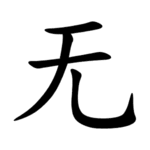| 无 | ||
|---|---|---|
| ||
| 无 (U+65E0) "negative, no, not" | ||
| Pronunciations | ||
| Pinyin: | wú, mó | |
| Bopomofo: | ㄨˊ | |
| Wade–Giles: | wu2 mou2 | |
| Cantonese Yale: | mòuh | |
| Jyutping: | mou4 | |
| Pe̍h-ōe-jī: | bû | |
| Japanese Kana: | ム mu / ブ bu (on'yomi) な-い na-i (kun'yomi) | |
| Sino-Korean: | 무 mu | |
| Names | ||
| Japanese name(s): | 无し/なし nashi 无/ぶ bu 无繞/むにょう munyō 既の旁/すでのつくり sudenotsukuri | |
| Hangul: | 없을 eopseul | |
| Stroke order animation | ||
 | ||
Radical 71 or radical not (无部) meaning "nothing" or "negative" is one of the 34 Kangxi radicals (214 radicals in total) composed of 4 strokes.
In the Kangxi Dictionary, there are 12 characters (out of 49,030) to be found under this radical.
无 is also the 62nd indexing component in the Table of Indexing Chinese Character Components predominantly adopted by Simplified Chinese dictionaries published in mainland China, with 旡 being its associated indexing component.
无 as an individual character is a variant form of 無. In Simplified Chinese, 无 is used as the simplified form of 無.
Evolution
 Bronze script character
Bronze script character Large seal script character
Large seal script character
Derived characters
| Strokes | Characters |
|---|---|
| +0 | 无SC/variant (=無 -> 火) 旡 |
| +5 | 既 |
| +7 | 旣Kangxi/KO (=既) |
| +9 | 旤 |
Literature
- Fazzioli, Edoardo (1987). Chinese calligraphy : from pictograph to ideogram : the history of 214 essential Chinese/Japanese characters. calligraphy by Rebecca Hon Ko. New York: Abbeville Press. ISBN 0-89659-774-1.
- Lunde, Ken (Jan 5, 2009). "Appendix J: Japanese Character Sets" (PDF). CJKV Information Processing: Chinese, Japanese, Korean & Vietnamese Computing (Second ed.). Sebastopol, Calif.: O'Reilly Media. ISBN 978-0-596-51447-1.
External links
Wikimedia Commons has media related to Radical 071.
This article is issued from Wikipedia. The text is licensed under Creative Commons - Attribution - Sharealike. Additional terms may apply for the media files.